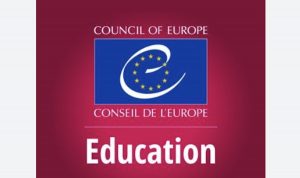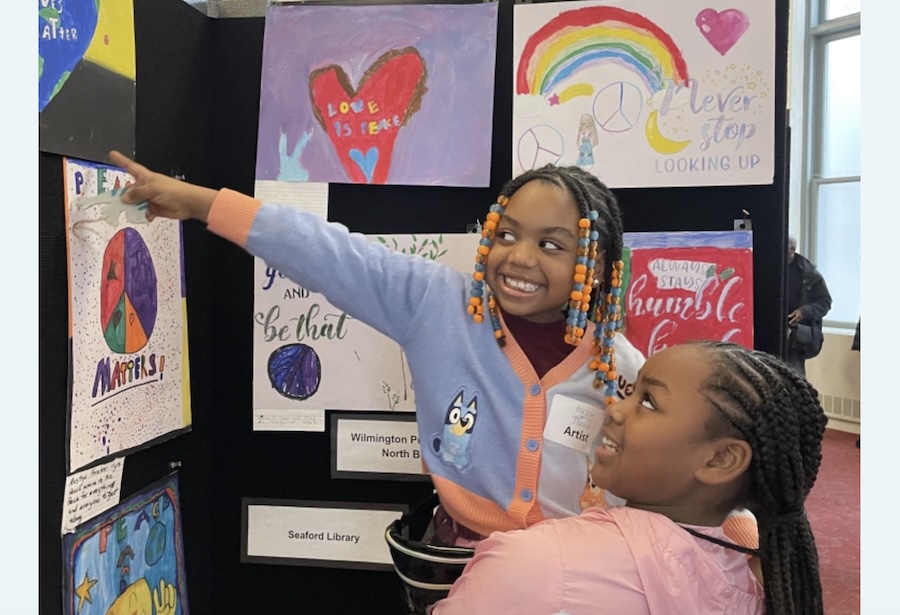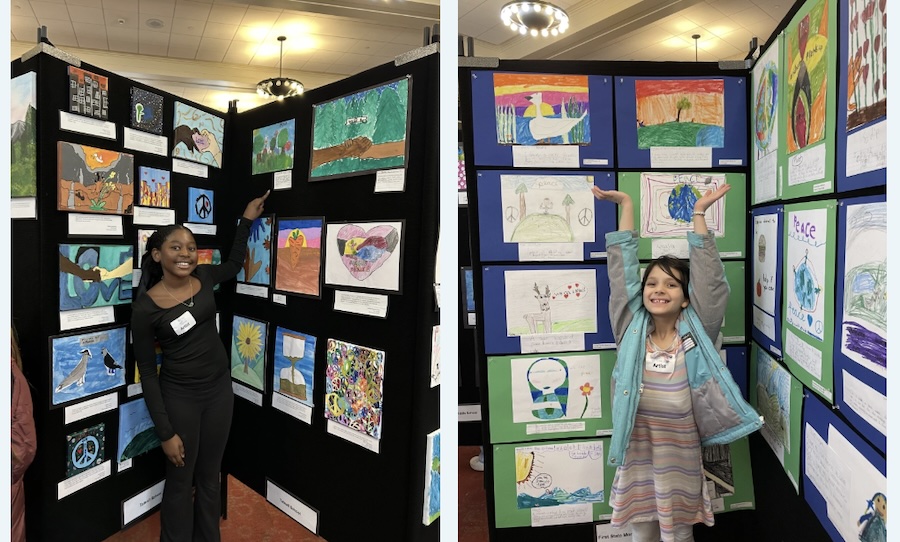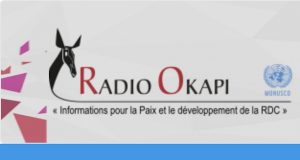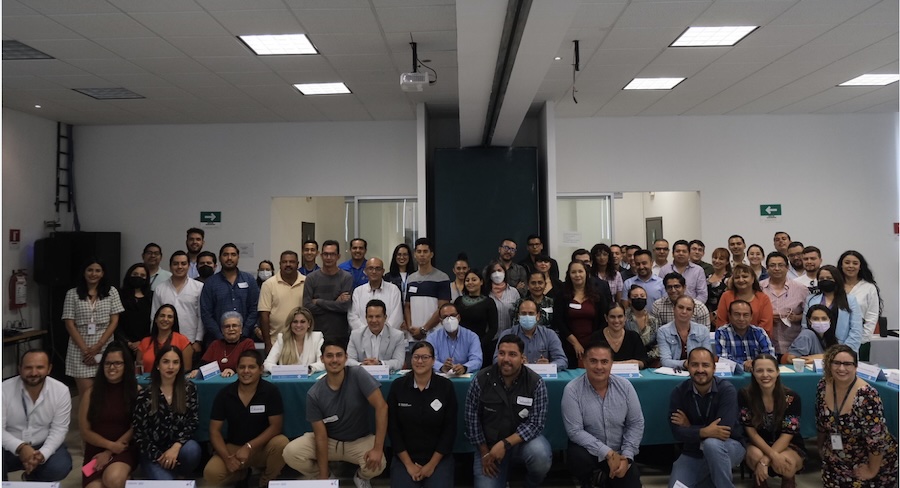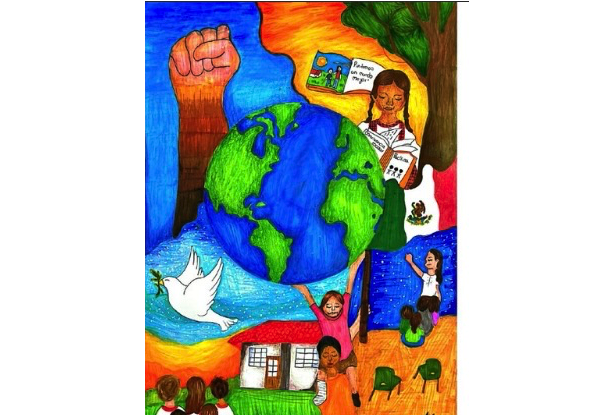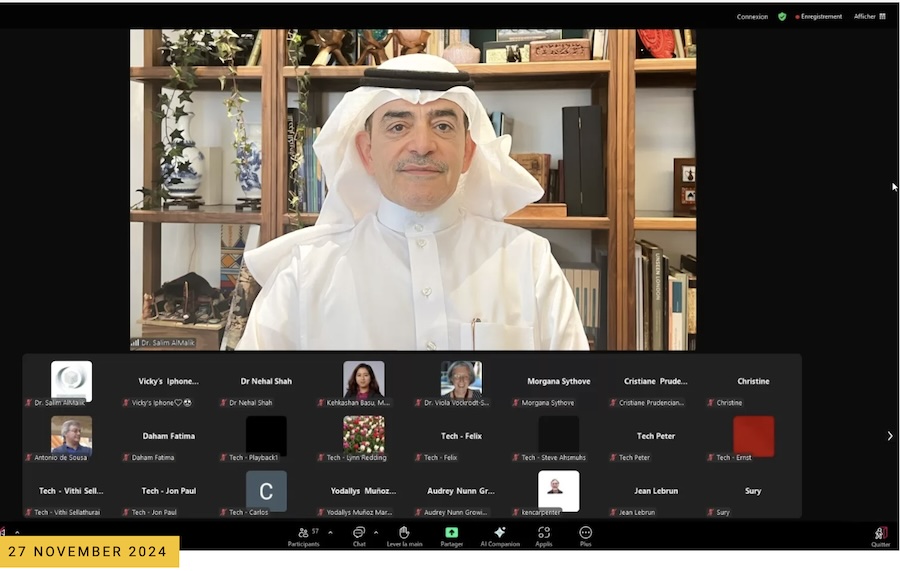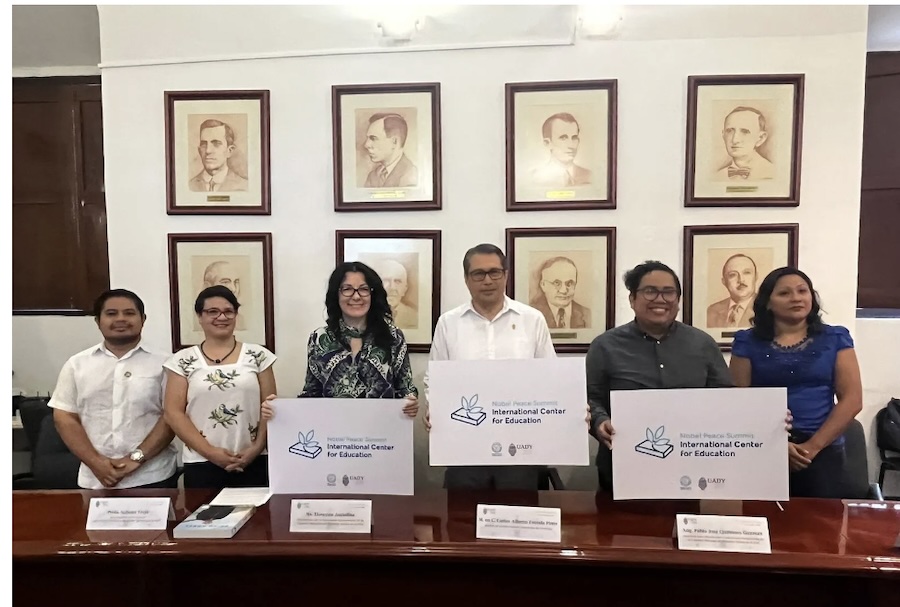EDUCATION FOR PEACE .
An article from Nonviolence News
In the sweep and bustle of the year’s struggles, it’s sometimes hard to see past the disaster headlines. Yet, remarkable progress was made by nonviolent movements worldwide. In this special report, Nonviolence News has gone into our archives and pulled out the gains, victories, and successful solutions that occurred in 2024. We counted 366+ stories – this article highlights many of them and you’ll find the others in the complete list in our Research Archives.
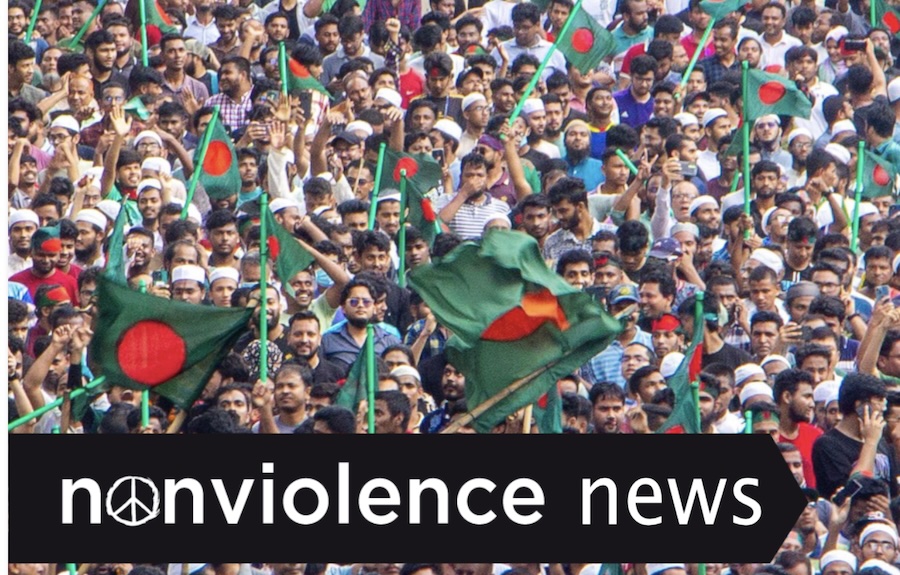
Let’s start with the big ones. Mass protests erupted many times this year from Argentina to France, Indonesia to Georgia. Some of them rose up against tyrants and autocrats and won. South Koreans, for example, held immense mass protests to prevent the president from implementing martial law and stealing power. Even after they succeeded, over 1 million people returned to the streets to force their politicians to impeach the president. In Bangladesh, students launched demonstrations to end unfair job quotas … and wound up ousting the prime minister, forcing the chief justice to resign, and bringing back exiled Nobel Prize Laureate Muhammad Yunis to lead the new government.
It was a remarkable year for people-powered democracy. Bolivians thwarted a coup attempt. Mexico elected its first female president. Indigenous Guatemalans held a 100-day sit-in to ensure the landslide-winning presidential candidate could take office. Indonesian protesters compelled their parliament to halt an election bill they felt would weaken the chances of opposition candidates. Kenyan protesters got President Ruto to withdraw a finance bill with tax hikes. Senegalese students and poor people kept their elections on track amidst the president’s repeated attempts to delay them.
When we organize, we win.
That major lesson is becoming more obvious with each new study. In 2011, researchers Erica Chenoweth and Maria J. Stephan unequivocally proved that nonviolent action works twice as often as violence. This year, several new studies grabbed headlines touting the effectiveness of nonviolent action. The Climate Emergency Fund demonstrated that disruptive actions are having notable impacts and lowering carbon emissions. Another report found that protest movements are 6 to 12 times more cost effective than charities at making change. And you know where the best movement organizers in the world are located? Africa. That continent has hosted more mass movements than any other region in the world and boasts the highest rates of success.
Looking at labor struggles, a study on 2023 worker strikes showed that the uptick in organizing has led to wage increases that haven’t been seen in 35 years. When workers organize, it pays off – literally. Being in a union means you’ll make $1.3 million more over your lifetime than if you’re non-unionized. In 2024, workers showed that strikes, boycotts, and protests are effective. Argentina’s labor unions mobilized 1.5 million workers in a general strike that halted President Melei’s ‘mega-degree’ of austerity measures. The French Farmer Protests used tractor roadblocks around Paris to secure promises of cash, eased regulations, and protection from unfair competition among other demands.
Across the US, strikes and other actions won wage increases for workers at Waffle House, Kroger warehouses, Cornell University, Apple, American Airlines, Boston University, Northern New Mexico College, Boeing, Daimler Truck, US Foods, Washington State University, and General Motors. Strikes also worked for automotive technicians, dockworkers, nurses, and steelworkers. In addition, labor organizing made important gains around remote work, contract tiers, back pay and reinstatement, collective bargaining, labor laws for domestic workers, unionization, the right to disconnect from work-related calls, union-busting, healthcare plans, retaliatory license revocations, workplace safety, and farmworker protections.
Other campaigns for economic justice made gains, too. Massachusetts passed a “Tax The Rich” law in 2022, which not only supplied $1.5 billion for the free school lunch program, it also provided much-needed improvements to their public transportation system and tuition-free education for community college students. Its success prompted 10 other states to try to do the same. Connecticut’s Baby Bonds Program to bridge the racial wealth gap has inspired other states to explore the strategy. Twenty-two states raised their minimum wages this year.
In the United States, debt relief measures – once considered an impossible dream – are growing with Los Angeles abolishing medical debt for 150,000 people, St. Paul, Minnesota, erasing $100 million in medical debt, Arizona abolishing $2 billion, New York City pledging another $2 billion, and a grassroots group in Maine fundraising to eliminate medical debt for 1,500 people.
Swiss retirees campaigned for a pension boost and rejected later retirement ages. South Africa and Iceland both report that their 4-day work week programs were a huge success. Cuban protesters forced food rations from their government during widespread shortages. Mexico’s first female president is de-privatizing oil and gas, electricity and internet companies. And a strategic, determined campaign by US diabetes patients used picketing and protests to get some of the insulin production industry to lower prices on the life-saving drug.
Seeing these stories makes you wonder what our world would be like if these policies were the norm, not the exception. Imagine what your city or town would feel like if medical debt was abolished, babies received investments in their futures, the 4-day work week was standard, and the rich were taxed to make society safer and healthier for everyone.
Keep envisioning this world … and add in these successful programs from 2024. Imagine if you lived in a city where doctors prescribed ‘culture vitamins’, nature, and ‘walking therapy’ for mental health and social connection, acclimatization programs forged deep friendships between locals and new arrivals, the library had no late fees, and city-wide rent reductions took place regularly. Imagine if, in all cities nationwide, Housing First policies ended homelessness, low-income residents got free passes on public transit, teen courts used peer-to-peer strategies to keep youth out of jail, and school lunches came from local farms and cooks. Every city in the nation could have free or affordable electric car shares that make vehicles accessible to everyone, free childcare, and bike give-away programs that equalize pedal power for all. If one community can use these tools, they can be implemented in many more. We could have gender equity in transit drivers, speed cameras, and lower speed limits leading to fewer accidents; anti-overdose vending machines saving lives, and agrihoods providing local food and green spaces. Clean air laws could ban high polluting cars and increase kids walking to school. Community investments could replace over-policing on subways. Unarmed mental health crisis responders could be used instead of police with guns. And empathy programs could not only stop school bullying, they could transform bullies into changemakers.
(continued in right column)
Question(s) related to this article:
Can peace be guaranteed through nonviolent means?
(continued from left column)
These kinds of nonviolent solutions reduce harm and save lives through economic and social justice. And when it comes to saving lives, there’s another set of stories worth lifting up, too: the remarkable work of peace teams, violence prevention programs, and unarmed protective accompaniment. These programs are stopping violence in Sudan, Guatemala, Honduras, Mexico, and Colombia. Women’s Protection Teams are offering physical safety and gender-based empowerment in Iraq. They’re working to prevent Missing & Murdered Indigenous Women/People and racist murders from claiming more lives in Winnipeg, Canada. They’re stopping political violence during the lead-up to the United States’ elections. They’re also providing protective presences after hate crimes and training targeted Asian communities in how to increase community safety. Violence prevention programs are at work in dozens of cities across the United States, addressing gun violence. The use of large anti-racist demonstrations in the United Kingdom also prevented right-wing attacks on mosques and Muslim community members in the wake of mass shooting.
When it comes to racial justice, the clear super-stars of organizing in 2024 were Indigenous Peoples. Land Back efforts regained a wilderness lodge in Alaska, 31,000 acres in Penobscot territory in Maine, and 1,000 acres of the Onondaga Nation’s ancestral lands in New York. The Winnebago Tribe in Nebraska regained 1,600 acres that was seized illegally 50 years ago. Shasta Indian Nation in California won back 2,800 acres. Year after year, the Prairie Band Potawatomi have bought back land to re-establish their reservation in Illinois. British Columbia formally affirmed Indigenous ownership of 200 islands by the Haida Gwaii. The 5,700-year-old sacred site of Shellmound was returned to the Ohlone through the Sogorea Te’ Community Land Trust. The University of Minnesota returned 3,400 acres to the Fond du Lac Band of Lake Superior Chippewa.
On top of all those impressive victories, there’s a growing trend to put national parks and wilderness areas into Indigenous stewardship, either directly or in co-management agreements. Ahousaht and Tla-o-qui-aht First Nations will care for Clayquot Sound’s forests. The Chumash Tribe will oversee a 4,500 acre marine sanctuary. The Miccosukee Tribe will costeward the Everglades National Park. The Kitasoo Xai’xais First Nation’s marine protected area recently became Canada’s first certified “blue park”. The Yurok Tribe will co-manage the ‘O Rew Redwoods Gateway.
LGBTQ+ issues have been in the crosshairs of conservative kickback, but some major victories were also achieved this year. Thailand became the first Southeast Asian country with equal marriage laws for same-sex couples. Hong Kong’s top court affirmed same-sex marriage rights, particularly LGBTQ+ housing and inheritance rights. Mexico made trans-femicide a crime. The US reinstated protections for LGBTQ+ persons under Title IX. Washington State now requires LGBTQ+ inclusive curriculums.
While the pro-Palestinian movement has not yet achieved a ceasefire in Gaza, they did achieve an extensive number of strategic objectives in the longer effort to halt the genocide. The International Court of Justice found that BDS – Boycott, Divest, Sanction – is not only legal, it’s obligatory. Boycotts in Kuwait, Lebanon, Qatar, Syria, Iran, Iraq, parts of Turkey, and other regional nations led to a 48.2% drop in profits for US-brands like KFC, Pizza Hut, Baskin Robbins, Costa Coffee, and Krispy Kreme. BDS also forced Pret a Manger to drop plans to open 40 stores in Israel.
Cities, businesses, pension funds, and universities divested from either some or all of Israel companies or weapons makers, including Norway’s sovereign wealth fund and pension fund, APCO Worldwide, Itochu Corporation, MIT, the Union of Painters and Allied Trades, Union Theological Seminary, Sacramento State University, Trinity College, Evergreen College, Portland State University, UC Davis, Hamtramck, MI; Richmond and Hayward, CA; Portland, Maine; and a host of others.
In addition, Germany, Spain, and Belgium Wallonia Region halted weapons shipments to Israel. Canada suspended 30 weapons shipments. Activists in Morocco, Spain, and Gibraltar worked together to halt 300,000 barrels of military-grade fuel from reaching Israel. Bogota, Colombia, blocked coal exports to Israel. The US even withheld a token military shipment (a pittance compared to its massive funds and weapons handouts to Israel). The movement also pushed Australia, Canada, Sweden, and other countries to restore UNRWA funds.
When we look back at 2024, we should remember the gains that were hard-won and significant, even if the final victory has not yet come. The climate movement is confronting this same challenge, winning over and over again, yet losing so much as continued inaction hurtles the planet into collapse. In the face of genocide and ecocide, it is understandable to feel despair and futility. But a closer look at the progress on climate issues should remind us to keep going.
Renewables now power 45% of the European Union’s energy, and it’s contributed to the EU’s record 8.3% decrease in greenhouse gas emissions. In the US, 80% of new electricity generation came from solar. The US put $64 million of housing funds into energy efficiency, solar panels, and heat pumps. Solar power at US K-12 schools has quadrupled this decade. Electric vehicles outnumber gas cars in Norway. Tajikistan required all new buildings to install solar panels. One month after the last dam was removed from the Klamath River, salmon were already spawning in traditional egg-laying grounds. An impressive 77% of universities in the United Kingdom have divested (or committed to divest) from fossil fuels.
Thanks to the relentless disruptions of Just Stop Oil, the United Kingdom committed to ending all new fossil fuel permits for exploration and extraction. The UK also blocked a major coal mine and is forcing all mining projects to be weighed against the climate crisis. Norway halted plans for deep-sea mining, as did Hawai’i. Minneapolis, MN, organizers shut down a polluting foundry. Courts blocked three harmful methane gas projects in South Texas. The KXL Pipeline’s cancellation appeal got thrown out of court. Amazon dropped a plan to tap into a gas pipeline to power its data center. Greenpeace activists’ drilling rig occupation halted a gas project in the North Sea. Earthjustice blocked a toxic copper mine in the Minnesota Boundary Waters Area. Portuguese activists halted an ‘ecocidal’ airport. India’s climate movement blocked an Adani coal mine. Tree-sitters saved a stand of old growth forest from logging in Oregon. New England activists closed the region’s last coal plant. A US federal court invalidated Wyoming oil and gas leases for failing to consider climate impacts. California towns are banning new gas stations. Rural Maine communities stopped a mine near their iconic Mt. Katahdin. The Dutch pension fund divested $3 billion from oil and gas. Hawai’i replaced its last coal plant with a battery for solar and wind. The US funded 60 new solar projects to install 1 million new systems for low-income families. The ozone layer is expected to be fully recovered from human-caused damages by 2064.
Each of these wins came about because of relentless, bold, creative nonviolent action that grabbed headlines, halted destructive industries, built solutions, pressured political leaders and decision makers, and persevered despite the odds being stacked against them.
Upon reflection, 2024 was not just a year of disaster and political upheaval. It was also the year that Julian Assange was finally freed. It was the year Net Neutrality was restored. It was the year that corrupt leaders fell from power in South Korea and Bangladesh. When we remember all of these, we also remember the most important thing of all: nonviolent action achieved all this.
What will we use nonviolence to accomplish in 2025?
_______
Note: as impressive as this article is, it’s only a fraction of what was achieved in 2024. You can explore all 366+ stories in our 56-page Research Archive where we’ve sorted them by issue.
Image: Bangladesh victory march, 2024. Photo by Rayhan9d, CC BY-SA 4.0
– – – – – –
If you wish to make a comment on this article, you may write to coordinator@cpnn-world.org with the title “Comment on (name of article)” and we will put your comment on line. Because of the flood of spam, we have discontinued the direct application of comments.
